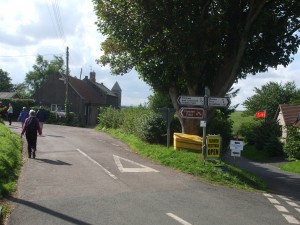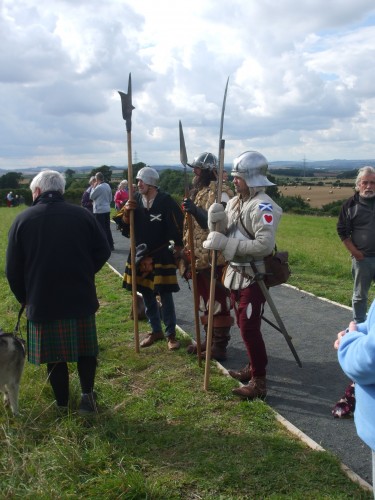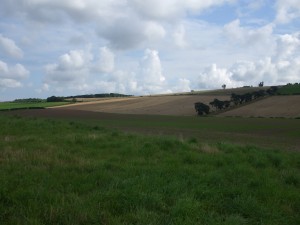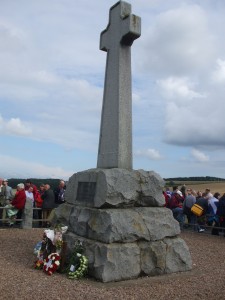The 500th anniversary of the Battle of Flodden hasn’t been much publicised in the Scottish media over the last couple of days. But some of us have done our best to comemmorate the occasion, and to acknowledge the sacrifice of around 14000 Scots, English and Welsh soldiers who died there. There are, in particular, a series of events currently ongoing in and around the Scottish and English borders, courtesy of the Flodden 1513 Ecomuseum, and I was lucky enough to attend a couple of them.
On the 9th September, I joined the battlefield walk led by the very capable Clive Hallam-Baker of ‘Remembering Flodden’. It didn’t start until 3.30pm, so in the morning I was free to extend the Flodden pilgrimage to include some of the sites connected with James IV and his fateful journey south of the border. Etal Castle was first on the agenda, before I headed to Flodden and joined the small horde that was mustering at the Flodden Monument.
There must have been several hundred people there. All following the walk in real time on the anniversary of the date of the battle (not the actual day, there have been changes in the calender in the intervening centuries). It was a very moving experience, the mood set by a piper paying ‘Flowers of the Forest’ at the monument at 3.30pm. when the first volleys of the Scots guns actually took place.
But it was the following day that proved truly special. I’d spent the morning continuing my James IV tour, calling at Swinton Old Kirk, where the death knell for the Flodden fatalities was rung once news of the defeat crossed the border, and Ladykirk, a late 15th/early 16th century church which has strong connections with James IV. But in the afternoon it was back to Branxton for a civil service commemorating the dead.
Held in a large marquee just outside Branxton village, the atmosphere at first was reminiscent of a busy county show, without the livestock. But once the commemoration service was underway, the mood was transformed. The event was arranged by a number of the local churches, and very moving and poignant it was, too.
There was no triumphalism on the part of the victors. There was no resentment on the part of the losers. Just a tangible sense of bewilderment at the futility of it all. Representatives from local communities on both sides of the border brought flags and banners to be laid there. Even the French were there. And the event itself was populated by a respectable number of clan chiefs, there on behalf of their ancestors who died there.
But the high point of the afternoon must surely have been the passionate address by Dame Judy Steel. Who spoke out eloquently on behalf of James IV, Scotland’s forgotten Renaissance king. Whose many achievements in science, the arts and education have been forgotten in the wake of his last, catastrophic defeat at Flodden.
It was a very moving experience, and one I felt priviliged to attend. It wasn’t particularly comfortable, because recent world events of course cast a long shadow, making the losses of Flodden (incurred on both sides) as relevant today as they ever were. 500 years on, the wars are still ongoing, though not unfolding so close to home, thank goodness.
I’m dedicating this post to those who fell there whose lives I have been privy to over the past decade or so. To King James IV. To John, 1st Lord Sempill. To Matthew Stewart, Earl of Lennox; Archibald Campbell, Earl of Argyll; Adam Hepburn, Earl of Bothwell; Robert Crawfurd of Kilbirnie, Sir Adam Mure of Caldwell, Sir William Colville of Ochiltree; Sir Robert Colville…
And all the countless others who fought there. The minor barons and lairds, and the men-at-arms, from Renfrew, Ayrshire and much, much further afield.
Over the last few weeks, I’ve heard many positive statements along the lines of how well Scotland coped with the disaster she suffered at Flodden. But here in the west, the loss of James IV and men like John, 1st Lord Sempill was enormous. The ensuing unrest reverberated for decades, culminating, it could be argued, in the murder of the 4th Earl of Eglinton more than half a century later.
Just one more individual tragedy, a last echo of the disaster that had made such an impact half a century before.




